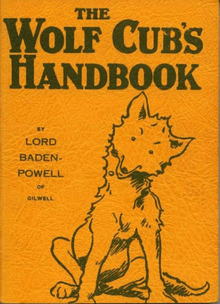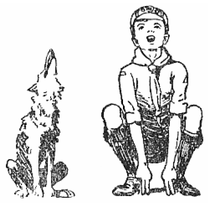The Wolf Cub's Handbook
 | |
| Author | Robert Baden-Powell |
|---|---|
| Illustrator | Robert Baden-Powell |
| Country | United Kingdom |
| Language | English |
| Genre | Children's literature |
| Publisher | Arthur C Pearson |
Publication date | 1916 |
The Wolf Cub's Handbook is an instruction handbook written by Baden-Powell for Wolf Cubs (present-day Cub Scouts) and pack leaders. The book is based on the theme of the jungle, described in a children's book, The Jungle Book, written by Baden-Powell's friend Rudyard Kipling.
Origins
By 1913, Baden-Powell's Boy Scout movement had grown beyond all expectation, but there was growing pressure in Britain, for some kind of scheme for boys who were too young to join the Scouts at 11 years old. Baden-Powell (B-P) asked his deputy, Percy Everett, to prepare a plan for "Junior Scouts" and the outline was published in the Headquarters Gazette in 1914. B-P was not entirely satisfied with the results, and whilst retaining elements of Everett's scheme, he set about putting his own mark on it. B-P gave the project a theme by basing it on Rudyard Kipling's Jungle Book, which had been published a decade earlier and was an established favourite with children.[1]
B-P decided to initiate the scheme with a handbook, similar in style to Scouting for Boys which had so successfully launched the Boy Scouts. He wrote the new handbook in chapters called "bites" because "this book is a meal offered by an old Wolf to the young Cubs". He included a précis of the Mowgli stories from the Jungle Book, and ceremonies and games based on them. Woven into this were instructional passages on health, fitness, camping, observation, knotting, semaphore, first aid, knitting and "being useful at home".[2] The first edition did not contain details of the tests and badges that Wolf Cubs were expected to pass, as these had yet to be finalised. At the end of 1916, Baden-Powell met Vera Barclay, a young Scouter from Hertfordshire who had written in the Headquarters Gazette about female leadership in the Scout Movement during wartime. She accepted Baden-Powell's offer of the post of national Wolf Cub Secretary and working closely together, the details of the Wolf Cub programme were devised and included in the second edition.[3]
Baden-Powell and Kipling

Baden-Powell sent Kipling the proofs of the new book asking for permission to use The Jungle Book material on 28 July 1916, after the work had been sent to the publishers. Kipling returned them in agreement without making any revisions.[4] Kipling and Baden-Powell had first met in India in the 1880s and had remained friends since then. Kipling would eventually be given the honorary title of Commissioner of Wolf Cubs[5]
Legacy
As intended, the Wolf Cub's Handbook was taken up with enthusiasm in the United Kingdom and across the British Empire. Translations were made into a number of languages. The Boy Scouts of America obtained the rights for the book in the United States and published their own edition in 1918, although Cub Scouts were not officially adopted until 1930 under a modified scheme.[6] Baden-Powell's book remained the official handbook for Cubs in the United Kingdom until the Advance Party Report of 1966 recommended that less emphasis be placed on the Jungle Book theme.[7]
References
- ↑ Walker, Colin. "Scouting Milestones: Scouting for younger boys - The Wolf Cubs". scoutguidehistoricalsociety.com. C R Walker. Retrieved 9 January 2015.
- ↑ The Wolf Cub's Handbook, Lord Baden-Powell of Gilwell, Arthur C. Pearson, 1916 (pp.2-5)
- ↑ Walker, Colin; and others. "The Story of Vera Barclay". www.isleofwightscouts.org.uk. Retrieved 3 November 2013. (pp. 2-4)
- ↑ Baden-Powell, Tim Jeal, Century Hutchinson Ltd 1989 ISBN 0-09-170670-X (p.500)
- ↑ "Scouting Milestones: Rudyard Kipling and Baden-Powell". Archived from the original on 2012-09-13.
- ↑ Scouting, Boy Scouts of America, March / April 1998 (p.13)
- ↑ The Advance Party Report, The Boy Scouts' Association 1966 (p.18)